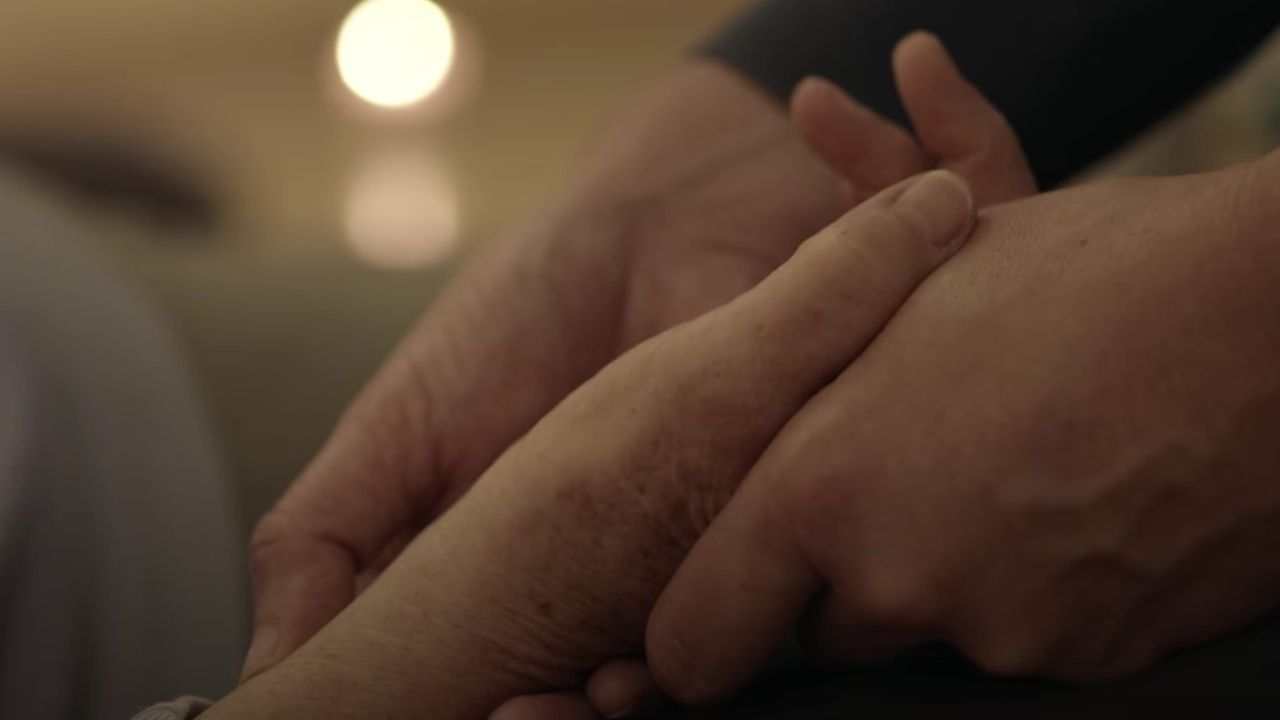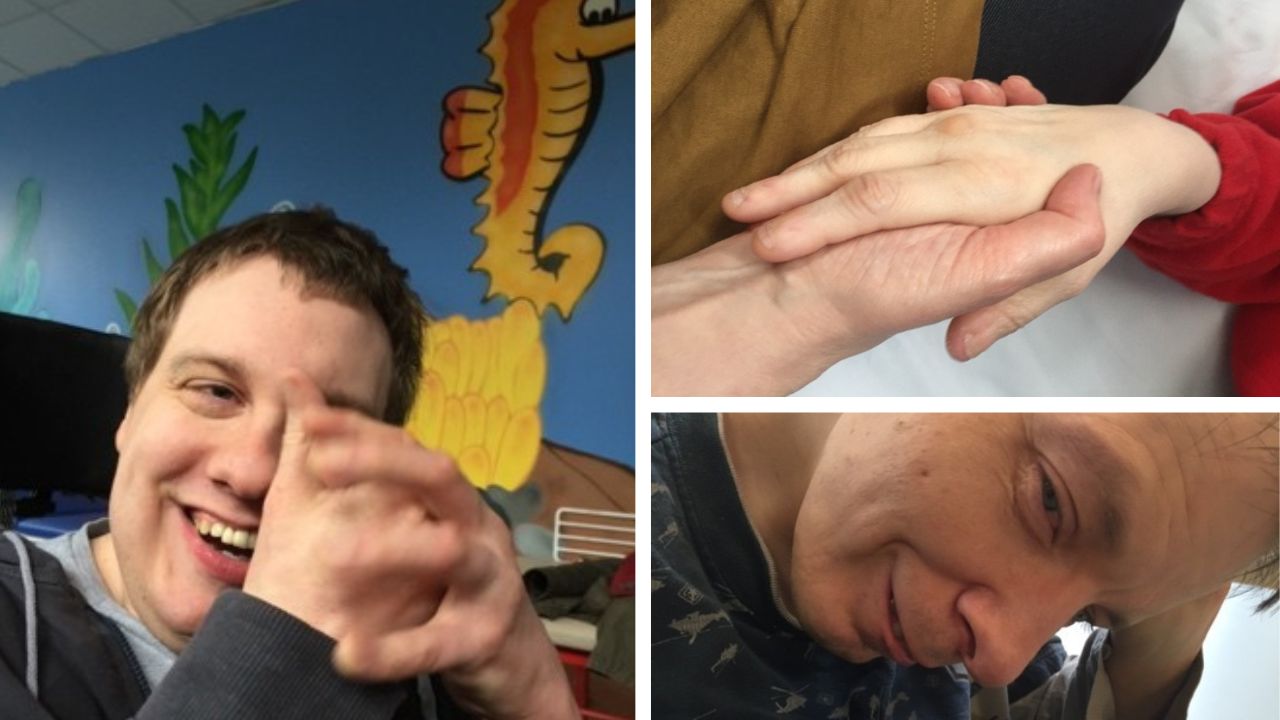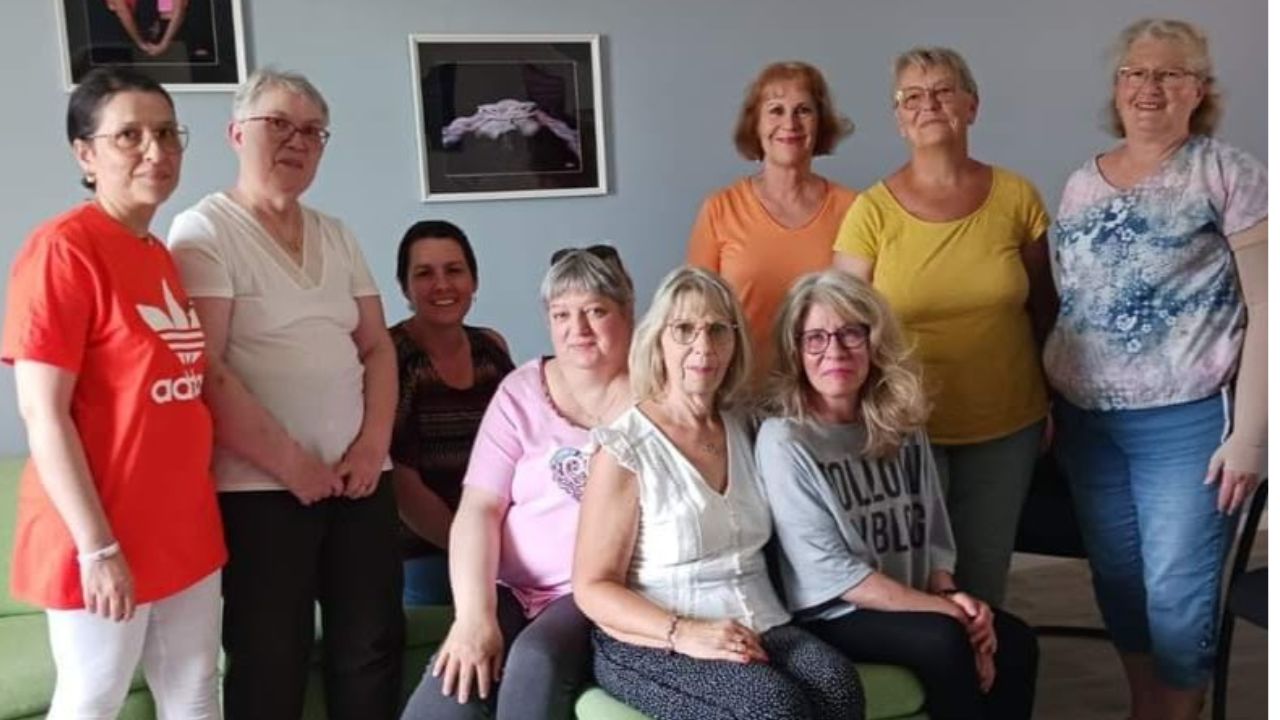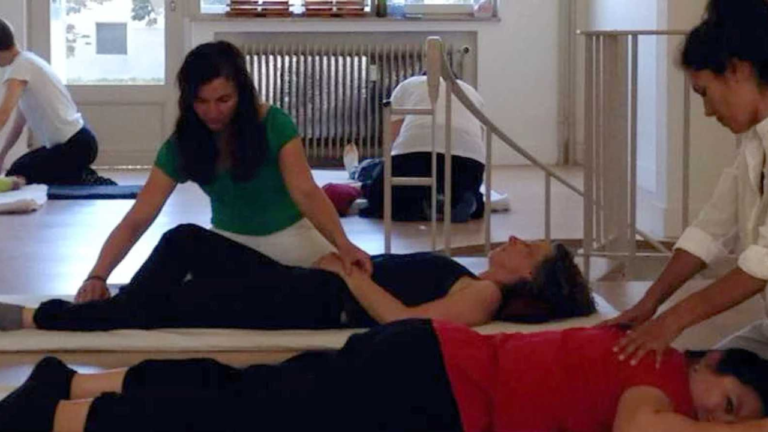
A Match Made in Heaven: on one side, a group of enthusiastic young therapists needing practical experience to graduate and on the other, medical staff within an institution open to complementary medicine. It was all sparked off by a casual conversation between a young Shiatsu therapist about to graduate and a friend who happened to be a medical doctor. In the end, it turned into a powerful experience that benefited everyone involved: the patients from a Brussels hospital, the medical staff and the pool of therapists who provided the treatments. Overwhelmingly positive feedback received after an initial trial session convinced medical staff to set up a regular Shiatsu program for their HIV-infected patients. Needless to say, the challenge was far from easy, as the patients were dealing not only with chronic physical illness but also with low energy levels and severe emotional trauma.
In the Spotlight
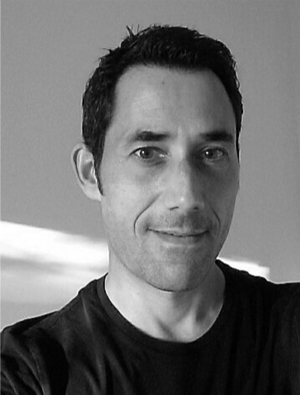
Richard Poláček
Originally from the Czech Republic, Richard is a member of the Belgian Shiatsu Federation (BSF). Between 2012 and 2017, he followed the teachings of Philippe Vandenabeele and Hiroko Kobayashi from the Shinzui Kai school in Brussels. He regularly attends Shiatsu development courses, in particular with Mike Mandl from Austria and with Haruhiko Masunaga, the son of Shizuto Masunaga, founder of Zen-Shiatsu at the IOKAI school, Japan. Since 2012, Richard has also been training in Chinese medicine and since 2019 in acupuncture at the Shenzhou Open Univesity of Traditional Chinese Medicine in Amsterdam. Richard graduated in Daoyin Yangsheng Gong and practices Nei Yang Gong (medical Qigong) and Tai Chi. Since 2018, he has been coordinating the group of volunteer Shiatsu practitioners who work with Cetim at Saint-Pierre hospital in Brussels.
Foreword
Shiatsu Resources Worldwide stems from our desire to curate success stories from therapists around the world in order to inspire the rest of the global Shiatsu community. In this spirit, even though there is no point in comparing any one story with another, it’s hard to think of a more appropriate story to start our project with. One of the reasons behind this impression is that it spotlights not well-established Shiatsu practitioners but a team of soon-to-graduate Shiatsu students.
They stepped-up to an extremely arduous task: giving treatments to a very unusual set of patients struggling not only with chronic physical illness but also with serious emotional trauma. These patients did not match the usual client you would expect to meet in a typical Shiatsu clinic. Treating such complex pathology would be a challenge even for experts in the field, but they were not intimidated by the task. Instead, through personalized Shiatsu treatments, delivered in a safe environment, they managed to create bonds with their patients and received extremely positive feedback from the staff of the hospital.
Once again, we are not talking about seasoned Shiatsu masters, but a team of young therapists who needed to fulfill an apprenticeship in order to complete their studies. And what an apprenticeship this proved to be! We had heard about Richard’s project and we were sent links to published articles but we felt there was more to it and wanted to bring some warmth and a human touch to inspire our readers. Chris arranged to talk with Richard via Zoom and during their half hour dialogue an even more inspiring picture emerged. Below you can watch a slightly edited version of the interview and here you can read a few ideas extracted from the same interview:
Chris: How did you come about the idea first of all? Where did it come from?
Richard: Well, we had to do an apprenticeship in order to validate our studies and we just realized there was not enough willingness from anyone to host us as practitioners, as young therapists, who wanted to graduate. I discussed this with a friend of mine who happens to be a medical doctor in one of the hospitals in Brussels and she informed me about Cetim, the center for infectious diseases in St Peter Hospital in Brussels, who had set up nice activities for their patients. So you have many patients who are HIV infected or have other major infectious diseases and alongside the treatment they receive at the hospital, they also have the opportunity to access a number of other services within the hospital. They offer qigong lessons, nutrition advice and many other activities. In our conversation, the idea came up: “why couldn’t we offer them Shiatsu?” I think what helped greatly was the fact that Qigong was already being offered, so the hospital was very open to something which was based on traditional Chinese medicine. We organized an open day and we had a trial session, and the outcome was extremely positive: patients were very happy about the treatments they received – a small group of practitioners treated around 15 patients and the feedback was overwhelmingly positive, hence the idea to continue this experience and set it up in a more regular way. And that’s what we did at the end of 2017.
Chris: That sounds amazing and what I’m picking up from you is that there was first of all a personal contact that led to the whole thing opening up.
Richard: Yes, I think she happened to know that I was doing Shiatsu and it was a personal conversation. I think what I’ve learned from it is not to be shy about talking about it, that we are doing Shiatsu. Of course, I had some apprehension because she’s a medical doctor and I thought: “how will she receive the idea to receive Shiatsu?” Luckily, she’s a very open minded person and she was very encouraging. She said: “Well, let’s give it a try – maybe it’s something that could benefit our patients”. Eventually, she and some other people from the hospital staff, nurses and medical doctors, subsequently also received Shiatsu sessions. This way, they could see and feel for themselves what it is to receive Shiatsu. I think that was another determining factor to get the thing going because people could really feel the benefits themselves and they could relate to what the patients said about their treatment outcomes.
Chris: Fantastic! You’ve touched on a theme here which I think is critically important – not to be too shy about what it is that we do and step forward a little bit, show your face, have those conversations and actively put yourself into the situations that you’re hoping to get yourself into.
Richard: Yes, absolutely! I think what really helped was the feedback from the patients. The patients were incredibly grateful for the sessions they had received during the first trial session. Many patients in the hospital in this particular section are of migration origin, a lot of people from Africa and the Middle East and all of them were incredibly open-minded to try it out, to receive treatments from people they didn’t know. The whole experience was based on mutual respect and gratitude.
Chris: it sounds wonderful. We’re talking here about win-win situations, aren’t we? And when that spins out into the world you get a multiple win-win effect by them spreading their energy and interacting with other people on a much more harmonious basis, is what I’m guessing. Would that be accurate?
Richard: Yes, you really see that kind of effect happening! We had the fitness space of the hospital where we could welcome the patients and we were a small team of five or six Shiatsu practitioners who turned up once a week. We gave treatments to approximately 15 patients over two hours or so. What was interesting is that we provided Shiatsu not in a closed space where you would be alone with your patient, but in a shared space. The patients also shared the space with us and I think that was rewarding on many levels because there was something happening in the room, a really nice working atmosphere. There was an incredible amount of attention. There was silence and you could feel a lot of things. 30 or 40 years ago, people with these kinds of illnesses were regarded as people you wouldn’t even touch, so there was something about the fact that we provided manual treatment for them which made it really special. I would say that because of the type of disease they have but also because many of them come from migrant origin, this created a kind of community feeling between them and also with us and that was a really nice thing.
Chris: I believe that is a beautiful thing to point out – that sense of community is something that’s lacking in many parts of our society right now in the West. So what you created there seems to be some kind of safe space for them, where they could feel comfortable beginning to interact with you. Another interesting thing which you pointed out was that you had a steady presence with the same people every week. Do you think that was an important part of it?
Richard: It was not exactly the same practitioners every week but we had a pool of approximately 10 practitioners and we attended on a rotating basis. There was a core group that came back again and again and that really did make a difference because there was a group feeling and we could sustain ourselves in case anything problematic occurred. I don’t believe I could have done this on my own and no one else could have done so on their own but here was a group dynamic that made it possible and that sustained it.
Chris: Very good. So, just a technical question: I’m guessing the treatments were somewhere between 30 and 45 minutes. Would that be accurate?
Richard: Yes, approximately 30-45 minutes for each treatment. At the beginning we thought that might be too short but we realized that it was pretty good timing because of the type of disease involved – we had to consider what people could take in. For some patients, you could feel that the treatment could have gone on longer but for others it felt like a good moment to stop.
Chris: Very important – we don’t want to overdose, we want it to be just right. Also, interesting because when you’re together in the room like that there’s a magnification effect, so maybe you don’t need such long treatments.
Richard: Yes I would say so! It was very touching to see people arriving, because some of the patients obviously knew each other so it was their weekly meeting for Shiatsu and for the hospital care. It was not just for a medical treatment, it was for something else – it was also to share a moment together and to take care of their bodies in a different way than they would if they were just going for a medical appointment.
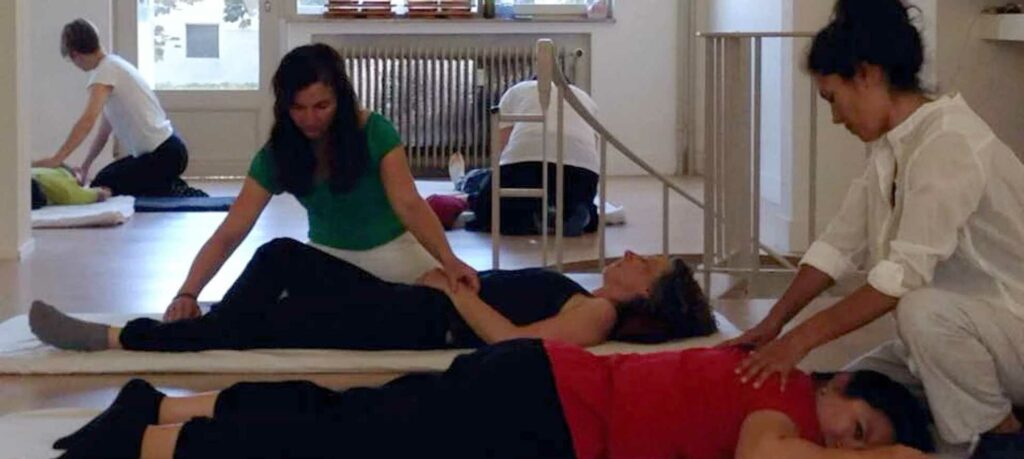
Postface
Every week a team of four shiatsu practitioners from Shinzui Bodywork International Institute provide Shiatsu treatments to approximately 8 patients from CETIM. The treatments take place in parallel in an open space, creating a familiar and secure atmosphere for patients, many of whom are women who have lived through a traumatic background of migration. Every patient can receive several Shiatsu treatments over a period of 6 weeks. The treatments are for free and all practitioners work as volunteers.
The feedback received so far from patients, doctors and psychologists at CETIM is very positive with many patients reporting improved sleep and digestion, increased energy and mind-body balance, as well as a reduction of stress, backpain and physical tension. During an evaluation carried out after several months, the vast majority of patients reported that their psychological and physical well-being has improved thanks to the regular Shiatsu treatments they have received.
For these young Shiatsu practitioners, the treatments given at Saint Pierre hospital are a very enriching experience. They are treating people from a social and economic background that are usually less familiar with Shiatsu and often do not have the necessary means to receive regular treatments. Many of the patients had never heard of Shiatsu before and were quickly appreciative of its positive effects. Practitioners can meet patients with severe health issues, accompany them over several weeks and observe their development. This undeniably contributes positively to the practical experience of the developing Shiatsu practitioners. Practitioners are always warmly welcomed by the patients who show their gratitude for the treatments. The sincere words of thanks and the happy looks and smiles of the patients provide a great reward for the personal investment of the practitioners, without whom this initiative would not exist.
I think that Shiatsu has absolute added value in treating HIV-infected patients, because people are dealing with lots of different types of pain. They are dealing with a lot of emotional issues, due to the fact that it is a sexually transmitted disease. There are many layers and many dimensions, which makes Shiatsu particularly appropriate. You can absolutely accommodate what the patient needs.
RICHARD POLÁČEK
